Seniors Step into the Workforce
- Details
- Hits: 2433

Senior Slump: “When second and third semester seniors stop doing their homework, give up on extra-curriculars that actually require work, develop mysterious illnesses, sleep until noon on a Tuesday, ‘forget’ to go to gym class…” (Urban Dictionary).
There’s a popular theory about the origin of Scarsdale High School’s Senior Options program: the senior slump. According to the theory, past seniors cut so many classes in the third and fourth quarters that they were in danger of not graduating. And so, the school created the Senior Options program to keep the graduating class on track to, well… graduate. The program requires students to complete a six-week internship of their choice. By giving seniors the opportunity to work in an area of interest, the program provides not only real-life work experience but also an incentive to meet the minimum number of educational hours required to graduate.
The program has given students the opportunity to write and publish novels, conduct research, and so much more. So, what are students up to this year?
Interior Design
 Jadyn Susanke and Cate Bellesheim are interested in art, real estate, and interior design. Both Susanke and Bellesheim plan to major in fashion design and management, so it’s no surprise that they found an internship that combines their interests. The two are interning at Homestead Advisors, a company that stages, organizes, and designs houses. There, Susanke and Bellesheim sit in on staging and design consultations and participate in physically staging and de-staging houses. In addition to consultations and staging, the two spend time organizing and labeling inventory. The pair recently created three design spreads of college dorm ideas for each other as one of their final projects. Due to the intimate nature of the job—meeting and visiting clients—Susanke and Bellesheim have had their fair share of strange interactions. Bellesheim shared an amusing story: “One time during a client meeting at our sponsors house, a husband and wife came in, and the sponsor’s dog did not like the husband and would not stop barking at him. Jadyn and I kept running around, trying to keep the dog calm and away from the husband.” After the meeting, the pair found out that their sponsor’s dog could be suspicious of strangers.
Jadyn Susanke and Cate Bellesheim are interested in art, real estate, and interior design. Both Susanke and Bellesheim plan to major in fashion design and management, so it’s no surprise that they found an internship that combines their interests. The two are interning at Homestead Advisors, a company that stages, organizes, and designs houses. There, Susanke and Bellesheim sit in on staging and design consultations and participate in physically staging and de-staging houses. In addition to consultations and staging, the two spend time organizing and labeling inventory. The pair recently created three design spreads of college dorm ideas for each other as one of their final projects. Due to the intimate nature of the job—meeting and visiting clients—Susanke and Bellesheim have had their fair share of strange interactions. Bellesheim shared an amusing story: “One time during a client meeting at our sponsors house, a husband and wife came in, and the sponsor’s dog did not like the husband and would not stop barking at him. Jadyn and I kept running around, trying to keep the dog calm and away from the husband.” After the meeting, the pair found out that their sponsor’s dog could be suspicious of strangers.
Medicine and Biology
The Scarsdale Volunteer Ambulance Corps (SVAC) senior options program has grown in popularity over the years. This program is a six-week EMT Basic certification course that teaches students patient care and response techniques. Alex Vetrone (pictured at top) is considering pursuing pre-med in college and would like to get first-hand experience with patient care and contact. He plans to volunteer as an EMT over the summer and throughout his college career. Each day, Vetrone sits through lectures and practices skills like taking vital signs. As a part of the program, each student is required to get ten patient contacts. Vetrone stated he had taken vital signs and questioned patients in the field. The hands-on practice required for the course often creates comedic situations. According to him, “One day we were practicing car extrications and our ‘victims’ [students in the class], decided to put on quite a show. While they were fake screaming and crying about how they didn’t want to be taken to the hospital, concerned pedestrians began to peak their heads into the SVAC parking lot.” The instructors, used to dealing with nosy bystanders, “just gave them a smile and a wave as [their] victims continued to scream bloody murder.”
Law
 Alicia XinAlicia Xin and Alison Jiang were involved in social and governmental extracurriculars throughout high school. Xin was particularly involved as a member and officer of Model UN. She stated that “I’ve done government internships before, and I wanted to look at different fields I could go into professionally and to help me make decisions about what to study.” Last summer, Jiang interned with
Alicia XinAlicia Xin and Alison Jiang were involved in social and governmental extracurriculars throughout high school. Xin was particularly involved as a member and officer of Model UN. She stated that “I’ve done government internships before, and I wanted to look at different fields I could go into professionally and to help me make decisions about what to study.” Last summer, Jiang interned with  Alison JiangShelly B. Mayer and Chris Burdick, where she learned more about politics. With their previous experiences, it’s no surprise that they decided to intern at Wilson-Elser, a law firm that specializes in medical malpractice, litigation, and insurance defense. There, the two draft summons and complaints, file documents, organize, and research for depositions. They not only love learning about interesting cases—illegal immigration, murder, insurance fraud—but also drinking the office’s free Swiss Miss hot chocolate.
Alison JiangShelly B. Mayer and Chris Burdick, where she learned more about politics. With their previous experiences, it’s no surprise that they decided to intern at Wilson-Elser, a law firm that specializes in medical malpractice, litigation, and insurance defense. There, the two draft summons and complaints, file documents, organize, and research for depositions. They not only love learning about interesting cases—illegal immigration, murder, insurance fraud—but also drinking the office’s free Swiss Miss hot chocolate.
Nature Conservation
The weather may be wacky, but some students are enjoying the late spring at local nature centers. Noa Shiloach wanted to work outside for her senior options and has been interning at the Rye Nature Center. She was interested in learning how to help the environment, which helped guide her to the nature center. There, she learns about any and all things related to nature, from bird species to invasive plants and insects. Shiloach regularly helps care for the native species, weeds, invasive plants, and plants trees. Although it’s often hot and rainy, she “…like[s] that it’s outside and that [she’s] making a difference to the nature center and environment.”
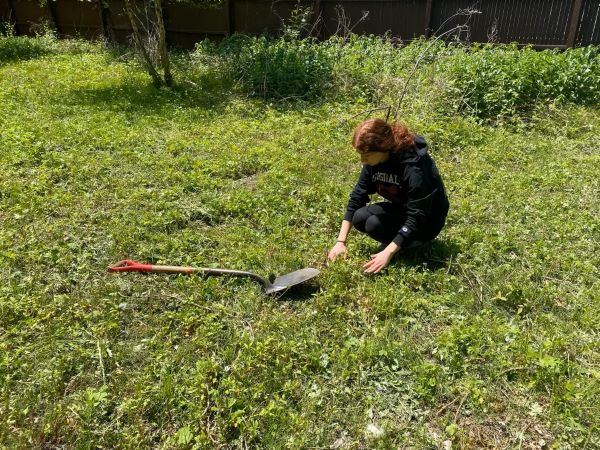 Noa Shiloach
Noa Shiloach
Education
You may have heard the phrase “Mazel Tov,” but what about “Mazel Tots”? Meena Venkatakrishnan is interested in becoming a child psychologist and loves working with young children. She decided to intern at Mazel Tots, a local Jewish nursery school at Scarsdale Synagogue, where she helps manage the classroom and entertain the “Tots.” Venkatakrishnan’s favorite part of her internship is “getting close to the kids and forming real connections with them” each day. The kids have adopted a fond nickname for her—Ms. Meena. There’s never a dull moment at the nursery. According to Venkatakrishnan, “just the other day I was told that if I were a cake, I’d be chocolate because I’m brown.” She certainly has her hands full, teaching her “tots” about more than just letters and numbers!
Investment
Varun Bansal has been involved in business and investment for years as the president of the Business Club and Scarsdale’s branch of the Distributive Education Clubs of America (DECA). Bansal stated: “I’ve always been interested in business and finance, and while I’ve done a lot of theoretical research and investing through clubs and competitions, I wanted to see how that compared to real life.” It’s no surprise that he decided to intern at Alight Capital, a hedge fund in the city. There, he not only applies his current knowledge but also builds upon it and learns more from his mentors. Although Bansal cannot make executive investment decisions, he sits in on various meetings and participates in company research. According to Bansal, sitting in on meetings “gave [him] more perspective on how professionals analyze companies and make decisions.”
Mechanics
 Avaneesh Rao is an aspiring mechanical engineer who has recently been fascinated by the design processes behind car manufacturing. He was excited to get some hands-on experience in an entry-level engineering environment by working at Casarella’s Auto Service on Hartsdale Avenue. There, Rao prepares the garage, performs basic repairs such as oil draining, and assists senior members in completing more advanced work. He describes his mentor as “patient” and the work environment as “relaxed” and “stress free.” Ultimately, Rao’s internship taught him “how to better communicate and cooperate in small groups,” skills that will be essential to his success as an engineer.
Avaneesh Rao is an aspiring mechanical engineer who has recently been fascinated by the design processes behind car manufacturing. He was excited to get some hands-on experience in an entry-level engineering environment by working at Casarella’s Auto Service on Hartsdale Avenue. There, Rao prepares the garage, performs basic repairs such as oil draining, and assists senior members in completing more advanced work. He describes his mentor as “patient” and the work environment as “relaxed” and “stress free.” Ultimately, Rao’s internship taught him “how to better communicate and cooperate in small groups,” skills that will be essential to his success as an engineer.
Baking
Halle Jakubowicz can often be found in the kitchen, surrounded by the delectable aromas of cookies, cupcakes, or some other baked goods. To get more “formal training” and improve her skills, Jakubowicz made it her mission to intern at a bakery for senior options. After weeks of searching, she found an internship at SugarHi, a bakery in Armonk run by twin sisters Hillary Assael and Elissa Weinhoff. There, Jakubowicz works as a cashier and designs candy bouquets, college  candy boxes, and gift baskets. Although she enjoys her tasks, she is disappointed that she does not have a more active role in the baking process.
candy boxes, and gift baskets. Although she enjoys her tasks, she is disappointed that she does not have a more active role in the baking process.
Cooking
Fuji Mart in Eastchester is more than just a grocery store; it’s home to a Japanese restaurant called Ramen Musashi. Like Jakubowicz, one of Haochen Liu’s favorite hobbies is in the kitchen—cooking. According to him, “being around food has always been a part of my life and learning about it in a professional environment has always been my goal.” Since the beginning of his senior year, Liu has been determined to intern as a chef for his senior options. After weeks of searching, he found a job at Ramen Musashi, where he works the morning and lunch shifts. In the mornings, Liu makes onigiri (rice balls) for the supermarket to sell, sets up the kitchen, washes and cuts ingredients for the day, and prepares boba (bubble tea.) In the afternoons, he prepares and packages delivery orders for hungry customers. Unfortunately, the restaurant is only doing takeout currently, which limits both the number of orders the restaurant receives and the number of orders Liu can make. Despite these limitations, his favorite part of his internship is all the “incredibly passionate and willing to teach” people that he’s met.
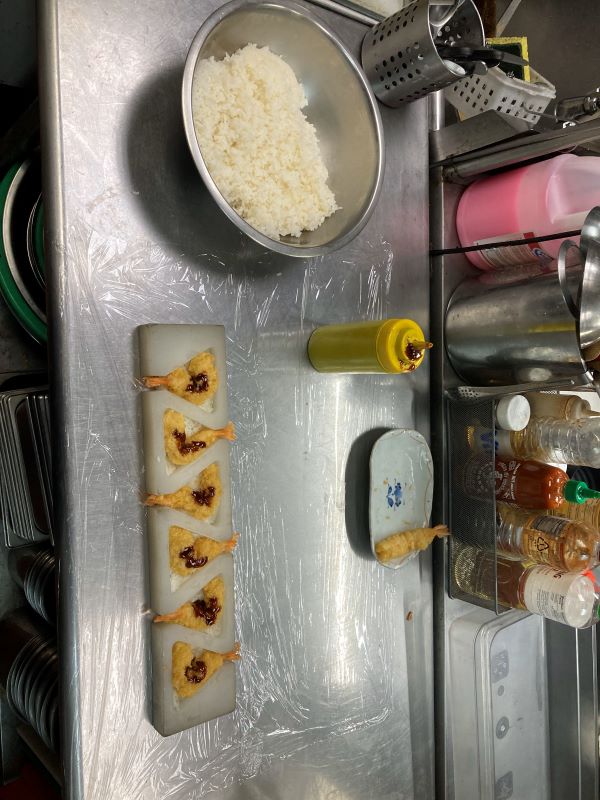
Like always, this year’s assortment of senior options internships has been particularly impressive. The program has not only allowed students to get work experience in a field of their interest but has also kept them on track to graduate. Jose Lamela, the program’s director, has ensured that each student has kept up with their 30-hour workweek requirements, fulfilling the state’s minimum time requirement. As the program ends, each student will be presenting to their teacher-mentor and peers. Then, it’s on to graduation!
Raiders to Keep Their Name, Inequities in Sports Participation, Gifts to the Schools and More from the BOE
- Details
- Written by: Joanne Wallenstein
- Hits: 2604
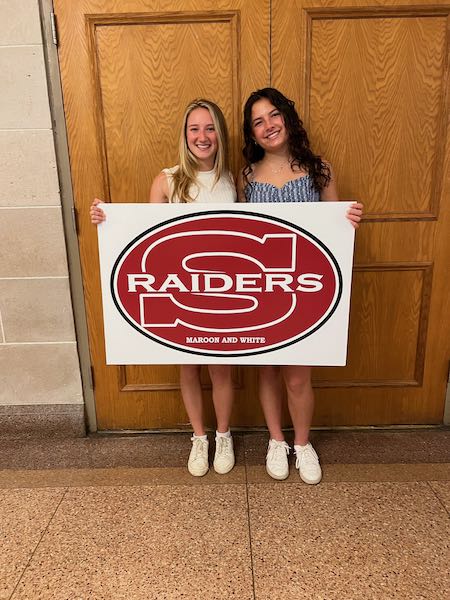 The NYS Education Department says Raiders can keep their name.At the last meeting of the school year, the school board got an update on the Raider’s name, discussed gift policy, named an interim Principal for Scarsdale Middle School and praised departing administrators Carol Priore and Stuart Mattey. The meeting was led by Board VP Ron Schulhof as Board President Amber Yusuf was out.
The NYS Education Department says Raiders can keep their name.At the last meeting of the school year, the school board got an update on the Raider’s name, discussed gift policy, named an interim Principal for Scarsdale Middle School and praised departing administrators Carol Priore and Stuart Mattey. The meeting was led by Board VP Ron Schulhof as Board President Amber Yusuf was out.
Cell Service
About improvements in cell phone service Schulhof reported that Verizon plans to have improvements at Fox Meadow and the high school in place by September and that discussions with T-Mobile are in process. He also noted that the Board held a retreat for self-evaluation and that he attended the ribbon cutting ceremony for the district’s first softball field at Greenacres. See more here.
Raiders to Keep Their Name
Superintendent Drew Patrick and Athletic Director Ray Pappalardi held a conference call with David Frank, who serves as the Deputy Commissioner for Education Policy to review the new mascot regulations. Patrick explained what he learned about the Raider name and research on the name from Colgate University who uses the same mascot. He said, “We have no evidence of ever using indigenous imagery with our team name. I am pleased to report that Frank agreed – and assured us that we can keep the Raider’s name. Therefore the matter is resolved!”
Book Borrowing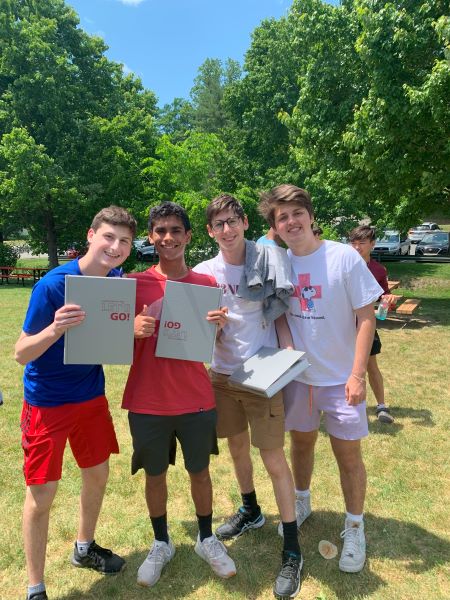 Seniors display their copies of Bandersnatch
Seniors display their copies of Bandersnatch
By the numbers: Patrick reported that Greenacres Library has analyzed their library book borrowing and found that one fourth grade student topped the list, borrowing 164 books this year. In total over 16,000 books were borrowed and over 2,000 students signed into the library out of class time. Patrick also noted that at the High School the 2023 yearbook, Bandersnatch, is out.
Graduation Dates
Patrick announced that the Alternative School graduation will be held on June 16 at 4 pm and the SHS Graduation will again be held in the evening, on June 22 at 6:30 pm on Butler Field.
Interim Principal for Scarsdale Middle School
Assistant Principal Chris Coughlin was officially named the interim Principal of Scarsdale Middle School effective July 1, 2023, replacing current principal Meghan Troy who is now an Assistant Superintendent.
 Coughlin was named Interim Principal of Scarsdale Middle SchoolFacilities
Coughlin was named Interim Principal of Scarsdale Middle SchoolFacilities
Stuart Mattey gave an update on summer facilities work planned for the district.
-The Heathcote offices will be renovated this summer
-Beginning June 12, work will be done at Butler Field to repair damage from flooding. The work should take about a week.
Sports Participation Numbers
Athletic Director Ray Pappalardi followed up on some statistics he had presented to the Board in April, which showed a decline in girls participation in sports. He reported that he re-ran the reports and found that participation in girls flag football and boys crew had been omitted from the report. When those numbers were included he concluded that participation is actually on a good trend. Scarsdale currently has overall participation of 58% boys to 42% girls for spring sports which is in line with 2018-19.
Pappalardi said he did some research to determine what was behind the disparity in girls participation rates in sports. He spoke to parents, interviewed girls, and held focus groups.
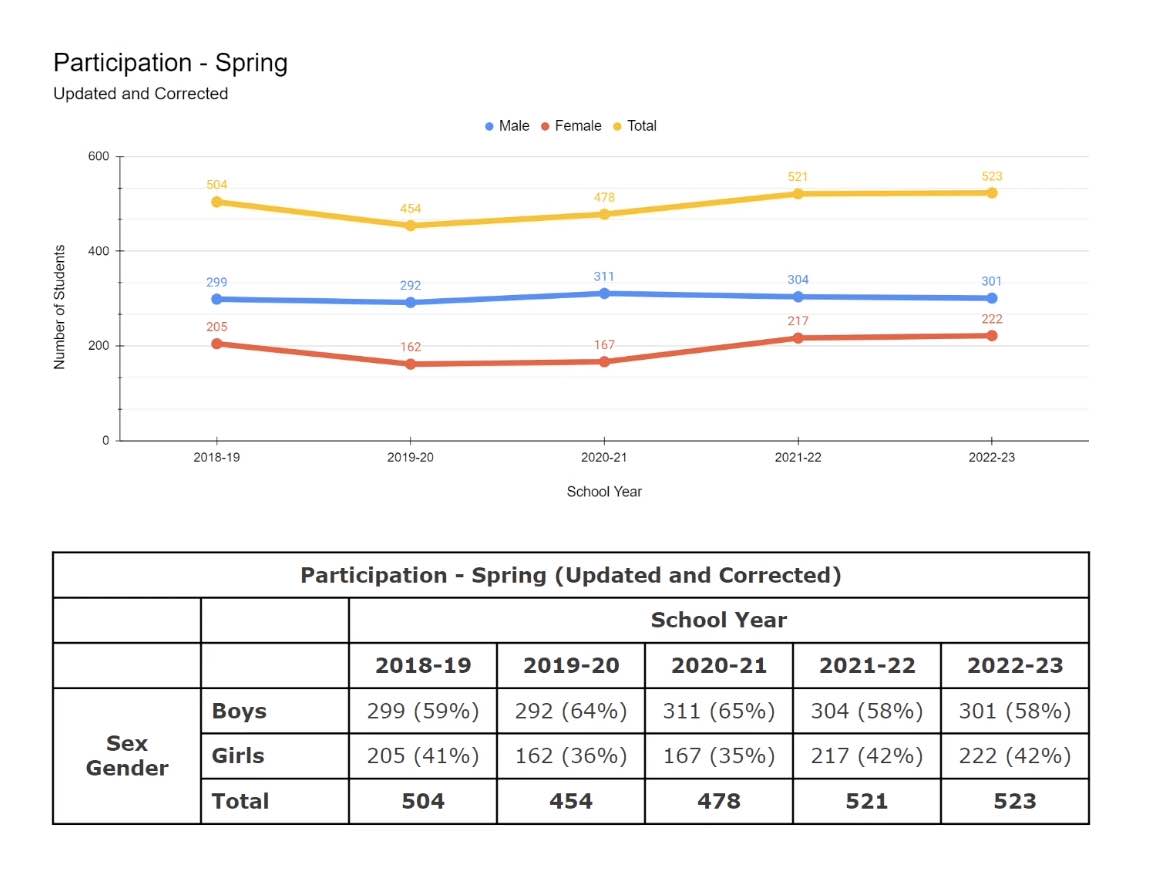
He found that the following factors influenced girls decisions:
-A perception of competence – kids know what they are good at.
-Traditional vs. non-traditional sport participation – things like dance and alternate activities
-Expectations for participation in youth and high school sports are not always the same.
He plans to address these concerns in the future with:
-Clearer communication about our purpose and values, especially related to equity
-Development of a common language and shared purpose
-Inclusion of ISO’s (include parents, coaches and ISO’s, in the high school transition)
-Examination of our programs – need a streamlined survey process.
Jessica Resnick Ault thanked Pappalardi for coming back with more concrete numbers. She asked about the process is for assessing the introduction of some of those additional non-traditional sports?
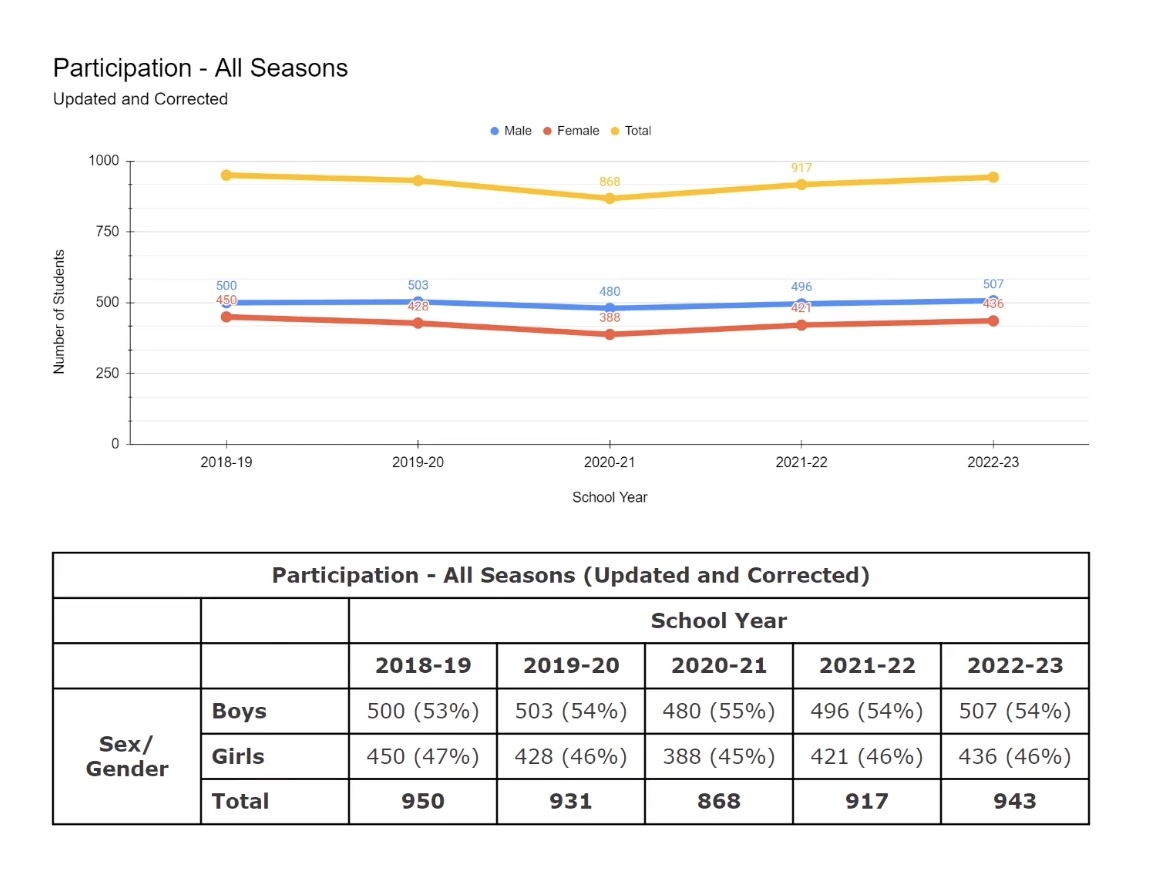
He replied, “We assess the level of student interest and our ability to run these programs. At the middle school, we look for trends that will drive participation in our programs at the high school. We are going to try to make the transition easier from the Youth programs to the high school programs. “We will try to bridge that level of interest or a spectrum of interest for student athletes so that there's a balance of fun for fun sake, and competition, so that we don't drive students away with high levels of competition.”
Ron Schulhof said, “Are you collecting data on whether this would be the students first sport or a potential replacement?” Pappalardi said, “For example, Flag Football for girls has not become a siphon off of any other sports. I think we've had two girls who came from other sports out of the 40 on both teams. He added, “At the middle school we do try to gather information about interest and decide whether that is sustainable, and then whether there's competition for it.”
Safety
Eric Rauschenbach reported that he and Mike Spedaliere attended the first annual school safety summit put on by the New York State Education Department. He said, “There was a wealth of classes around Crisis Response, around bringing belonging into the school safety world as a major pillar, which we've been doing here. It was a validating experience seeing what the best practices were and in large part being able to check off those best practices things that we practice here in Scarsdale.”
He also said, “We are doing our final testing of the integrated lockdown system the week after school ends. So there will be notices going out to the community that they may hear lockdown announcements and drills at the various schools around the district. “
Case of the Missing Tortoise
Rauschenbach continued on a lighter note. He said, “At Fox Meadow it seems that we had the case of a missing tortoise. It disappeared out of one classroom and was found making a flee for it down the hallway. So we are investigating how the tort made its way out of a classroom and found his way down the hall. Patrick asked, “Does it have its ID?”
Summer Curriculum Work
Edgar McIntosh said that this summer teachers will be working in collaborative groups to update refine, align and enrich existing curriculum and assessments as well as expand and develop new curriculum and assessments. He outlined a long list of projects that will be done including interdisciplinary work on belonging, wellness, inclusion, diversity and equity. At both the high school and middle school they will be looking at grading practices and curricular and instructional alignment. “
Public Comment
During Public comments, PTC President Lauren Grossberg said, “I'm speaking on behalf of myself as in my role as the PTC president but not on behalf of the PTC. So you may or may not know but traditionally the outgoing PTC president makes a statement at the last Board of Ed meeting each year with a focus on wishing the outgoing board members the best of everything and unusual circumstances. We do not have any outgoing board members this year. This has only happened two other times since before 2010. The last time being 2017-2018.
Regardless, it didn't feel right to pass up the opportunity to say how much I valued being in the role of PTC president and being able to liaise with the board are open dialogue is crucial to the work we all do on behalf of our school community. I look forward to seeing all the great work this repeat board does next year. I'd also like to take a quick moment to wish Stewart Mattey and Carol Priore, a wonderful retirement and re retirement and welcome Megan Troy and Andrew Landon to the cabinet.”
Gift Summary and Policy
Following a discussion about a large gift from the Fox Meadow PTA to build an outdoor classroom at a prior meeting, Superintendent Patrick introduced the topic of gifts to the school. As a summary this year, the board accepted a total of $327,182.91 in gifts from 11 different donors or donor organizations. The largest single gift came from the Scarsdale Schools Education Foundation to fund the purchase of furniture for the Scarsdale Middle School library.
He said, “We also received generous gifts from each of our PTAs and from Maroon and White in addition to a few other organizations and individuals on behalf of the district. I want to express our collective gratitude once again for these gifts and we're grateful for the generosity of our community and appreciate each and every one of these gifts.
He introduced a draft of a document that describes gift procedures which you can see here.
He explained that the intent of the document is to help bring clarity and support organizations and individuals who are interested in gifting guidelines. It outlines what to think about, what to do, who to contact when, and how the process works from the district’s side, once an offer of a gift is made through the form of a letter or a notification.
He said, “The first step in the in the procedure as we drafted it flushes out some guiding questions like, is the proposed gift part of the core educational program and therefore something that districts should take financial responsibility for? Other questions are, does the proposed gift accelerate implementation of an idea or a program or a practice? How does it fit into the donors or the donor an organization, multi-year commitment? These are not questions that have to be written down and responded to, but they're a guide to the thinking that might take place as a donor individual or organization contemplates making a gift. “ The remainder of the document moves in the steps that are required for drafting of a memo submission.”
He continued, “The idea here is that this is a draft and then perhaps once we've lived with it for a little while, could become like an exhibit attached to the policy, and that way people would know it's linked. So that's something that board can consider and we may recommend doing that.”
Board members thanked Patrick and commented:
Suzie Hahn Pascutti said, “You might consider putting “equity” as just one of the considerations?
Bob Klein said, “Is it typical or not to put number boundaries on gifts or in terms of the amount or not?”
Jim Dugan asked, “How would this policy affect the process in terms of timing for a gift to be approved by the by the district and the board? Patrick said, “This doesn't mark any change the policy. This is just a procedure and it largely reflects the same timing that we followed as long as I've been paying attention to this.”
Speaking for Amber Yusuf, Ron Schulhof said, “In terms of step two, where there's discussion and a request for more information, the donor organization should provide that to the Board based on that discussion.”
For item three, whether it would be helpful to provide background on who the donor has already spoken to. I think the idea that Amber was trying to convey was just to bring as much information to the board ahead of time to get ahead of any questions that might come up.
Patrick discussed the benefit of outdoors spaces for education vis-à-vis the proposed gift from the Fox Meadow PTA.
Gift for Edgewood Elementary
The Board accepted a gift for $2,600 for the Edgewood School to purchase wireless mics to improve the acoustics at performances.
Praise for Mattey and Priore
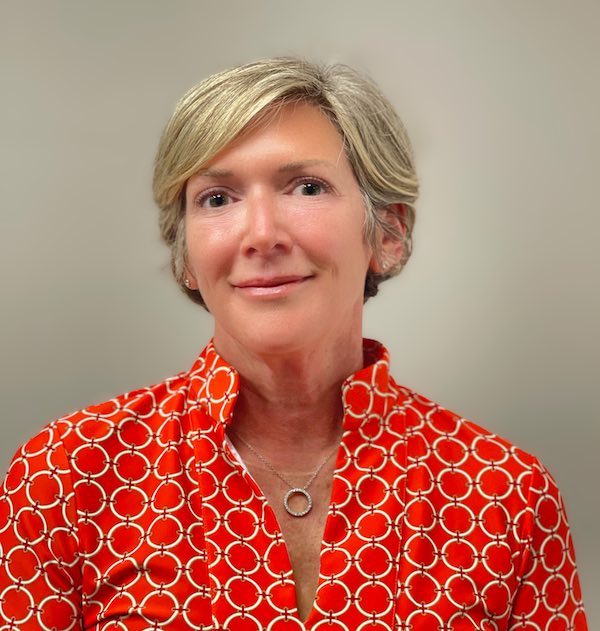 Carol PrioreAfter a discussion of the Board’s self evaluation process, the Superintendent made some comments about retiring cabinet members Carol Prioire and Stuart Mattey.
Carol PrioreAfter a discussion of the Board’s self evaluation process, the Superintendent made some comments about retiring cabinet members Carol Prioire and Stuart Mattey.
He said, “So part of our plan for this section of the meeting was to recognize Ron and Amber for their incredible leadership this year, leading all of those ambitious goals and priorities that were just discussed in the self-evaluation. But we're going to wait till Amber's back and we're going to take the chance on July 6 to say some nice words and celebrate your leadership over the last year, both of you but we also have two other colleagues at the table who are moving on and this is the last board meeting of the year. So I'll start with Carol.
Carol as I took over as Interim Superintendent just over a year ago, I knew the biggest practical challenge facing me was how on earth would we navigate all the HR work ahead as I left that role? You stepped in with confidence, a can do attitude and with the necessary knowledge and skills to handle the work. Most importantly, however you develop the trust and confidence of those around you. Your previous service to Scarsdale meant that you had relationships and bonds with people but it is really your positive attitude, empathy, student centered belief system and your kindness that have made your work here so successful. So thank you from the bottom of my heart for all that you've done for this district.
Turning to Assistant Superintendent Stuart Mattey, Patrick said, I can’t express how much your partnership has meant to me. Truly from the day I arrived in Scarsdale you helped me to read the culture. You supported me heavily in those early contract negotiations, then you let me take on more responsibility as I found my own footing. A careful considered discussion has been par for the course on every single topic we have put our heads together on, and since I have taken on the role of Superintendent you have taught me even more. And one of the things I am most proud of is this past budget process which we managed both behind the scenes and in public. Thank you for the strong foundation of practice that you’ve instituted over the past eight years. You have set Scarsdale and your successor up for success. I know you will enjoy the next phase of your life with Robin and your family and it is very well deserved.
Board Vice President Ron Schulhof also thanked Mattey and Priore on behalf of himself and Board President Amber Yusuf.
He said, “Stuart: Thank you for your dedication and commitment to this District and our students over the past 8 years. Throughout your time in Scarsdale you have overseen a budget process that provided the resources for our district to continue its educational excellence while also managing this process in the tax cap era. You have also successfully helped pass multiple bond issuances as well as ensuring the successful implementation of the bond work that touched every building in the district and most recently culminated with the bond to address the long overdue renovation of the High School Auditorium.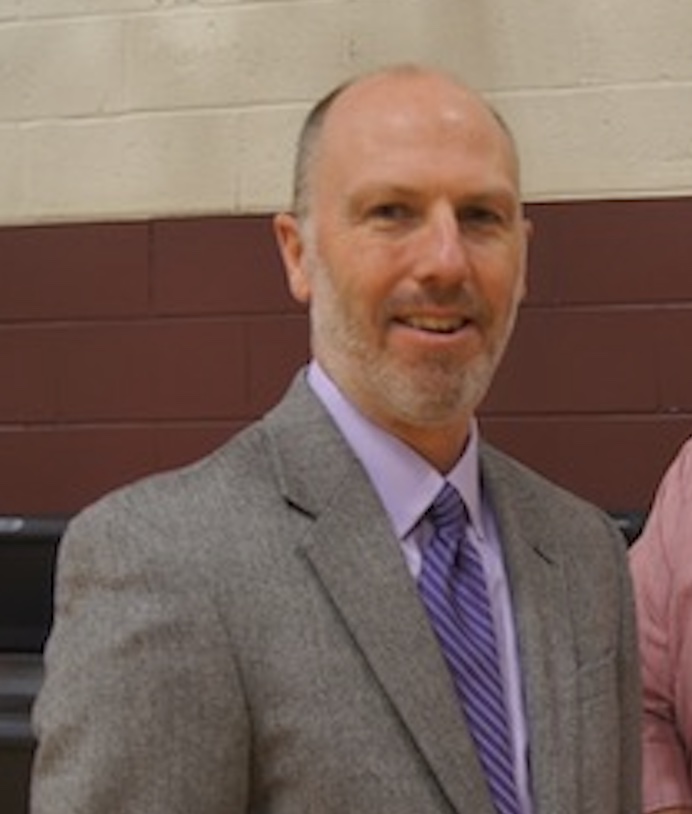 Stuart Mattey
Stuart Mattey
While the community may see your work on the budget and bond firsthand at board meeting, you lead many other important areas that are student focused.
Your work to bring food service to four elementary schools will have a lasting impact, and your willingness to work with parents to bring healthy and nutritious options to all students is notable. For several years you also managed the District’s Safety and Security work, including ushering in many key improvements throughout the District such as the security vestibules and safety monitor program. In addition to all these areas, you have also managed our large and complex transportation program and have kept our buildings running day in and day out through quite a wide array of challenges, from flooding to pipe breaks to emergency repairs.
We wish you a wonderful retirement and hope you’ll stop by for the first performance in the new auditorium space.
Carol: Thank you for taking the time out of your retirement to come back to Scarsdale and support our district this year. It’s been quite the busy year for recruiting at all levels throughout the district and our buildings. You ensured our human resources and leadership development areas continued the high level of excellence throughout the year and maintained our collaborative approach to hiring and professional development training. Thank you for your leadership during the collective bargaining process this year. We wish you all the best as you continue your retirement and thank you for being here for this year to support the Scarsdale Schools.”
Non-Sibi in Action at Scarsdale High School
- Details
- Hits: 2733
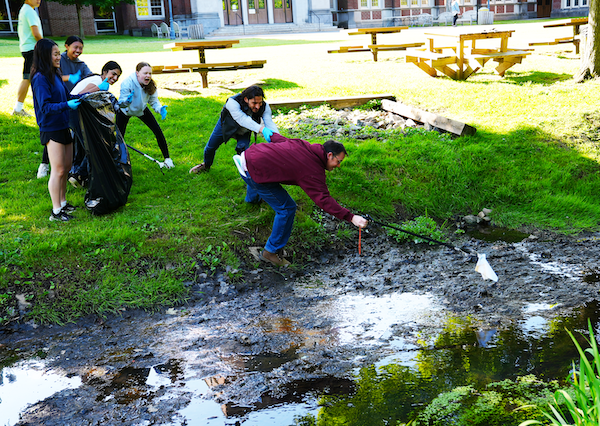 Superintendent Dr. Drew Patrick and World Language teacher Matthew Contino join forces to reach far-flung trash. Photo credit: Michelle VernaAt Scarsdale High School, the motto “Non-Sibi,” that is “not for oneself alone,” came to life on Friday, May 26th, when the school hosted its 2023 annual Non-Sibi Day and held 50 workshops where students participated in activities that fostered community awareness and encouraged local volunteerism. The event had activities for everyone, ranging from Asian Hate and Situational Awareness to Harnessing AI to a Self-Defense Workshop. Among them were the Brook Clean Up, Guiding Eyes for the Blind, Healing Tree, and Narcan Certification with the STAY Club.
Superintendent Dr. Drew Patrick and World Language teacher Matthew Contino join forces to reach far-flung trash. Photo credit: Michelle VernaAt Scarsdale High School, the motto “Non-Sibi,” that is “not for oneself alone,” came to life on Friday, May 26th, when the school hosted its 2023 annual Non-Sibi Day and held 50 workshops where students participated in activities that fostered community awareness and encouraged local volunteerism. The event had activities for everyone, ranging from Asian Hate and Situational Awareness to Harnessing AI to a Self-Defense Workshop. Among them were the Brook Clean Up, Guiding Eyes for the Blind, Healing Tree, and Narcan Certification with the STAY Club.
 Prior to the Brook Clean Up, the brook that runs through the Brewster Road parking lots had been inundated with garbage, no doubt the result of overzealous lunchtimes. The Brook Clean Up was composed of a short presentation detailing the effects of plastic on the environment, after which, students used grabbers, gloves, and bags to clean up trash in and around the brook. That morning the community came together to do something that the high school had been in dire need of—a brook beautification.
Prior to the Brook Clean Up, the brook that runs through the Brewster Road parking lots had been inundated with garbage, no doubt the result of overzealous lunchtimes. The Brook Clean Up was composed of a short presentation detailing the effects of plastic on the environment, after which, students used grabbers, gloves, and bags to clean up trash in and around the brook. That morning the community came together to do something that the high school had been in dire need of—a brook beautification.
The Scarsdale High School’s HELP Animals Club unites students with a love for animals to help organize fundraisers such as the cutest pet contest, bike/walkathon, bake sales, carnival booths, and more. The Club hosted Guiding Eyes for the Blind, a nonprofit organization that trains guide dogs for individuals with vision loss, for Non-Sibi Day. Guiding Eyes brought in several experienced handlers to teach students about the vitality of service/guide dogs for those who have disabilities. The organization’s guide dogs interacted with students, who participated in an activity that involved making felt chew toys for the dogs.
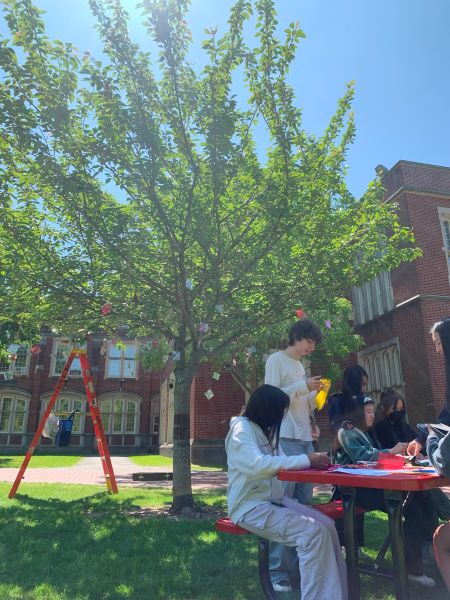 The National Art Honors Society Club created the Healing Tree, an interactive art installation, for last year’s Non-Sibi Day. The branches of trees that line the path of the entrance from Brewster Road were adorned with positive and uplifting notes written on colorful plastic sheets of paper. This year, students participated in a Healing Tree activity, where they added their own new notes to the tree.
The National Art Honors Society Club created the Healing Tree, an interactive art installation, for last year’s Non-Sibi Day. The branches of trees that line the path of the entrance from Brewster Road were adorned with positive and uplifting notes written on colorful plastic sheets of paper. This year, students participated in a Healing Tree activity, where they added their own new notes to the tree.
The High School’s Students Take Action for Youth (STAY) Club was developed and implemented by junior Caitlin Higgins. According to Higgins, “The STAY Club [is] a place for SHS students to learn, discuss, and take action against substance abuse in addition to supporting teens’ mental wellbeing.” For Non-Sibi Day, the club invited speaker Lauren Johnson, a drug prevention, treatment, recovery, and harm reduction activist. 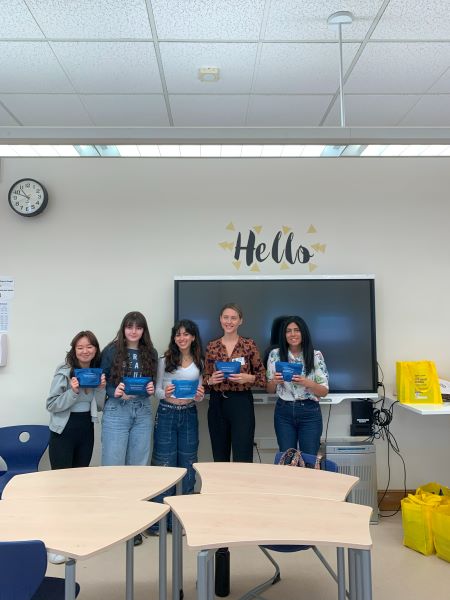 Johnson taught students how to recognize and prevent overdoses and trained them in the use of Narcan. Narcan, also known as naloxone, is a nasal spray used to treat opioid overdoses. Each participant received a free Narcan kit at the end of training and became certified to administer Narcan to individuals having a suspected opioid overdose.
Johnson taught students how to recognize and prevent overdoses and trained them in the use of Narcan. Narcan, also known as naloxone, is a nasal spray used to treat opioid overdoses. Each participant received a free Narcan kit at the end of training and became certified to administer Narcan to individuals having a suspected opioid overdose.
These were just a few of the many inspirational workshops presented at this annual event. Here is a list of the entire schedule:
 Students harvest, clean and bag produce from the SHS Garden for Feeding Westchester. Photo Credit Michelle Verna
Students harvest, clean and bag produce from the SHS Garden for Feeding Westchester. Photo Credit Michelle Verna
|
10 Things I Want You to Know about Autism |
Self-advocate Paul Morris will talk about his experience growing up on the autism spectrum, feeling different as a child, and how he now has several jobs and lives independently. This presentation will be co-led with Dr. Peter Faustino, School Psychologist at SHS. Together, they will share a list of things that every student should know about Autism. |
|
Asian Hate and Situational Awareness (Self-Defense) |
Brianna Cea, the president of the OCA chapter in New York, will give a short presentation on Asian hate in New York and how to spread awareness. In addition, she will teach students basic self-defense moves. |
|
ASL Interpreting the Pledge of Allegiance |
We will be teaching the ASL interpretation of the Pledge of Allegiance and the ASL alphabet. |
|
Breast Cancer Lesson |
In this session, you will learn about breast cancer: what it is, risk factors, and how it can be prevented and treated. We will then prepare gift bags to donate to breast cancer patients in hospitals. |
|
Brook Clean Up |
We will meet outside the Brewster entrance and do a short presentation on the effect of plastic on the environment. We will then go around the brook with grabbers, gloves, and bags to pick up the trash in and around the brook. |
|
Building Birdhouses |
We are going to be painting birdhouses out of recycled materials (mainly jugs and milk cartons) during the Non Sibi Day event. We will construct the birdhouses out of the recycled materials prior to Non Sibi Day with Ms. Colleary. |
|
Candle Decorating for Armenian Genocide Remembrance Day |
In honor of Armenian Genocide Remembrance Day, we will be decorating purple candles with either purple forget-me-nots, which symbolize the recognition and condemnation of the genocide, or any other creative design. Each student will have the opportunity to take home their own unique candle. |
|
Centro Hispano |
Centro Hispano works to help Hispanic families in Westchester. Staff from Centro Hispano will explain what they do and who they help, and have you make bracelets and write letters for their program. The bracelets will go to 6th graders who are part of their afterschool program called Mi Hermano/Mi Hermana Mayor (My Older Brother/Sister). You will create a bracelet with an inspirational word and a letter explaining the reason behind their choice of word. This will inspire younger generations to get involved in volunteer opportunities that could benefit the community in any way. |
|
ChatGPT, High School, and the Future |
In this workshop, the Model UN club will present the most recent developments regarding ChatGPT and other forms of AI specifically within the academic world and for high schoolers. Then student participants will be coached and asked to debate whether they would recommend schools resist and combat the new technology or embrace and embed it. The session will conclude with potential solutions that address many aspects and will hopefully resemble the diplomacy and compromise that the club roleplays throughout the year. |
|
Comics & Social Justice + Sketching Characters |
A presentation on the representation of social justice in comics with their societal impact as well as learning how to draw comic book characters. |
|
Cookies for a Cause |
The Jewish Culture Club is hosting a fun and interactive activity for students to make cookies and cards for residents of The New Jewish Home, Sarah Neuman, a nursing home in Mamaroneck. We aim to bring joy to students at SHS and senior citizens in the nursing home by continuing to spread support for each other throughout Westchester. |
|
Creating/Curating Art to Support Incarcerated Individual Adults |
The Promise We Share will provide a brief, holistic overview of NYC's criminal justice system with specific attention to the intersection of incarceration and mental health. After learning about the lack of access to meaningful programming for incarcerated adults, students will have the opportunity to create their own "creativity kits" to donate to New York City jails. Students may develop writing prompts, curate a collection of art print-outs and reflection questions, put together a drawing activity, design a meditation session, or create something else they are excited about! Through this activity, students will have a chance to harness their own passions to directly help address one of the most pressing failures of NYC's present-day detention centers. |
|
Cupcake Decorating and Donation |
We will be decorating cupcakes and then donating them to a food organization. |
|
De-Mystifying Dyslexia |
Do you know someone who has challenges with reading, spelling, or writing? Do you know someone who has dyslexia? Have you ever wondered why a fellow student gets extra time to take tests and you don’t? Come join Dr. Joanne Pierson of the University of Michigan’s DyslexiaHelp to learn the ins and outs about dyslexia. You may even win a prize. Go Blue! |
|
DIY Survival Kit Challenge |
Students will try to create a survival kit for different disaster situations and will only be able to choose 3 out of 6 tools per situation. They will learn how challenging it can be to get supplies quickly during a disaster as well as which tools are necessary during a disaster/emergency. Afterward, they will have an opportunity to revise their kits and take photos together! We hope to start a conversation and teach the significance of being prepared in a disaster! |
|
Domestic Violence Awareness |
The Girl Up Club will be hosting a domestic violence awareness and education activity for Non-Sibi day. Joined by facilitators from My Sister's Place, we will delve into topic areas related to prevention, stigmatization, and recurring stereotypes that are harmful to survivors and their journey to seek justice. This activity will begin with an information session, include a facilitated discussion, and conclude with a letter-writing activity. |
|
Get to Know LiNK (Liberty in North Korea) |
With speaker, Esther Park Chun, Senior Growth Coordinator at LiNK, this activity will introduce and inform students about LiNK and all the work they do to help North Koreans escape, relocate, and assimilate back into society. |
|
Guiding Eyes for the Blind—Service Dogs |
The Help Animals Club will be hosting Guiding Eyes for the Blind for Non-Sibi day. Guiding Eyes will be bringing in a few of their experienced handlers to teach about the vitality of service/guide dogs for those who have disabilities. They will also be bringing in a few of their guide dogs to interact with students and further their message of importance and value. We will also be running an activity that involves making felt chew toys for dogs. |
|
Habitat for Humanity Sandwich Making |
In an effort to combat the growing issue of hunger in Westchester County, the Habitat for Humanity Club will lead students in packaging meal kits for the hungry to be distributed to Community Service Associates in Mount Vernon and Hope Community Services – HOPE’s Soup Kitchen in New Rochelle. This includes making sandwiches and bundling them with a beverage, treat, and a note of encouragement, written by the students. |
|
Harnessing AI |
In this session, we will be demystifying some of the uncertainties about AI, talking about AI Ethics (eg. bias within AI), and various applications of AI that can specifically benefit the Scarsdale High School community. This session will also include an interactive coding that showcases some of the basics of machine learning. |
|
Headlines: Selling Stories & Pushing Narratives |
Being read to is one of the best ways to build a lifelong love of reading. Most of us have a favorite book or group of books that we remember fondly from childhood. Listening to a book and following along is a fun, low-stress way to engage in early literature…What if you could use SHS’ Non-Sibi day to build a library of ‘memories' for our Scarsdale K-2 kids? You can! During Read2Me you (with or without a buddy) can record a video as you read a book of your choice, upload it to our shared drive, and help build the elementary school's digital library. We supply the books…you supply the positive energy! |
|
Healing Tree |
The Healing Tree is an interactive art installation that would be made from students who are willing to participate. Notes would be written on colored plastic sheets of paper and placed into a clear envelope to be hang up on the tree by the Brewster entrance. |
|
Help Fight Period Poverty and Clothing Insecurity with 914 Cares |
Ms. Rosewater will lead a PowerPoint discussion briefly giving an overview of the real state of our county – that is, for example, one in which 40% of newborns are born to mothers on Medicaid – versus the stereotype that wealth abounds here. She will then discuss clothing insecurity and period poverty, and how addressing those issues with tangible items can have a positive impact. She will also touch upon pending federal legislation to make period products available for free in schools, and she will discuss other efforts by students to destigmatize this basic health/human rights issue. After the discussion and Q and A session, the group will help make packets of Bombas socks, laundry detergent sheets, and Flow Kits, which 914 Cares will distribute to its recipients. |
|
Hudson Link |
Hudson Link for Higher Education in Prison provides college education, life skills, and reentry support to incarcerated people, so they can make a positive impact on their own lives, their families, and communities, resulting in lower rates of recidivism and higher rates of employment, community regeneration, cohesiveness, and reciprocity. Our organization provide post-secondary educational opportunities for incarcerated students enrolled in programs at five correctional facilities in the greater New York area. Students will meet alums of the program to discuss topics such as Turn on the TAP, The Clean Slate Act, and DVSJA (Domestic Violence Survivors Justice Act). We will ask students to bring school supplies for the current and future students enrolled in Hudson Link's educational program. |
|
Invisible Threads: Small Acts, Big Impacts |
Small acts of kindness can result in much bigger impacts. The White Plains Hospital Club is thrilled to be hosting Laura Schroff, a #1 bestselling author, to discuss her book, An Invisible Thread. The book tells the story of how the lives of a busy sales executive and a disadvantaged young boy were shaped by what began as one small gesture of kindness. Please join us to hear about this special story, and spend time brainstorming and performing your own act of kindness by writing letters of gratitude to SHS community members as well as to healthcare workers at our local hospital. |
|
Kindness Rocks Event |
The Kindness Rocks event, in collaboration with the SAVE Promise club (Students Against Violence Everywhere), will promote kindness and joy within our community. Students will be able to paint rocks and come together to discuss resources/ways to prevent violence and connect with one another! |
|
Learn Interviewing Skills from Sleepy Coffee, Too |
This new nonprofit cafe in Sleepy Hollow is staffed by adults with disabilities. The unemployment rate for this population is as much as 80%. The cafe is operated with first-rate training and service. Let these amazing individuals teach you some interviewing skills. This is a valuable skill and students will leave inspired and wanting to put their talents in service of the greater good. |
|
Letters of Love |
Join the SHS Muslim club in writing "Letters of Love" for patients in children's hospitals all around the world. |
|
Making Salad Kits |
Join the SHS Garden Club in harvesting, washing, and packaging salad greens for distribution to those working at and receiving services from the White Plains Hospital. |
|
Marketing and Consumer Behavior |
The DECA Club officers will present on marketing and consumer behavior. Everyone who attends will get to learn about techniques of marketing, mediums, behavior patterns, and more. We will end the period with a fun game, where we will split the group into teams, and they will get to use their recently acquired knowledge to help run advertisements for a company. |
|
Mental Health Lesson with UNICEF Club |
We will teach a lesson about mental health including statistics, coping mechanisms, indicators that someone is struggling, and support systems. |
|
NAMI Ending the Silence Presentation |
NAMI Ending the Silence is a free mental health presentation designed to give students, families, and school staff an opportunity to learn the warning signs of a mental health condition, how to get help, and how to help someone. The presentation includes an informative PowerPoint and short videos as well as a personal testimony from a young adult living with a mental health diagnosis, about their journey to recovery. The presentation will be followed by a question and answer period. |
|
Narcan Certification with STAY Club (16+ ONLY) |
Learn how to recognize and prevent an overdose and get trained in the use of Narcan. Each participant will receive a free Narcan kit at the end of the training. (Must be 16 years or older to participate. In order to be certified, you must have a signed permission slip from a guardian). |
|
One Can Food Packing |
We will teach students about Bread of Life, a local food pantry, and about what goes into food packing. We will then have them pack cans collected by other students in a separate can drive to donate locally to Bread of Life. |
|
Phones as a Part of our Lives |
An informative and interactive workshop designed to bring awareness to students about the impact of our phones, and how we can learn to live with them in moderation. |
|
Public Systems Trivia |
Students will learn about the jarring realities behind NYC's child welfare and food distribution systems. Through news headlines and research reports, we will briefly demonstrate how the public's general lack of knowledge of their rights acts as a safeguard to protect the Administration of Children's Services from accountability. Through a high-energy game of Jeopardy, students will test their own knowledge and hear about activism strategies to support reform movements. |
|
Read2Me |
Being read to is one of the best ways to build a lifelong love of reading. Most of us have a favorite book or group of books that we remember fondly from childhood. Listening to a book and following along is a fun, low-stress way to engage in early literature…What if you could use SHS’ Non-Sibi day to build a library of ‘memories' for our Scarsdale K-2 kids? You can! During Read2Me you (with or without a buddy) can record a video as you read a book of your choice, upload it to our shared drive, and help build the elementary school's digital library. We supply the books…you supply the positive energy! |
|
Refugee Camp Simulation |
Students in Ms. Thompson’s Race & Ethnicity class and members of the Hearts & Homes for Refugees Club will guide visitors through eight stations that will give them a glimpse of the conditions that refugees across the world suffer. A guest speaker from Hearts and Homes for Refugees will discuss the work that the organization has been doing in Westchester since 2015. |
|
Self-Defense Workshop |
Our sessions will consist of safety awareness, basic self-defense techniques, fast, effective, and efficient striking, and basic escapes. |
|
SHS Non-Sibi Community Mural |
In this activity, each student will receive a puzzle piece to draw/illustrate on. As they finish, the pieces will slowly be connected into one large mural. |
|
Sparks & Rec: Straight-Up Coloring Edition |
Burned out? Feel like your fire is cooling? Down to your last embers? In this edition of Sparks & Rec, we'll be doing some straight-up coloring (mandalas and similar templates)! Side effects may include: focus, meditation, relaxation, laughter, and more! You might be saying, "But isn't Non-Sibi Day supposed to be in the service of others?" That's true, but it's hard to be good to others if we're not good to ourselves. Join us for a session of healthy zoning out, taking a brain break, and thinking about something other than school. |
|
Sustainable Shark Tank |
Students will be split up into small groups and each group will be assigned the same problem impacting a large community. They will have to create a business plan to solve any aspect of the problem whether their idea helps a small community or the whole world. After, each group will present their idea and product to their classmates and the “sharks”/ leaders of the session will choose the best sustainable plan. |
|
The Legacy of Housing Discrimination in Westchester County |
This presentation will explore the history of housing discrimination in Westchester County, and how efforts to build new housing could help to mitigate the county’s de-facto segregation. In this workshop, students will be given the opportunity to write a letter to local officials in support of building affordable housing, if they would like to do so. |
|
The Rise of Deepfakes |
Deepfake creators are new and increasingly promising yet dangerous tools that can be used to create stunning visuals or to impersonate people. Learn how deepfakes work, how to detect them, and how they will impact our world. |
|
Voter Suppression |
This is an interactive presentation where students will learn about voter suppression, voter rights, and the importance of voting. |
|
We Broke Up But Stayed Friends: Breaking Your Phone Addiction |
Overwhelmed by your phone? Losing time in your day to the rabbit hole of TikTok, YouTube, Insta? Staring at your screen when you should be asleep? Not sure how to talk to people IRL? Feeling phantom vibrations in your pocket when your phone isn't there? If you are experiencing these or a multitude of other symptoms, you may be suffering from phone addiction. Find out to to break it and create a healthy relationship with your phone while also giving your time and attention to every other part of your life. Learn how to prioritize, manage your time, bring back your passions and hobbies and find joy off screen. |
|
Witness Stones Project: Slavery in Scarsdale |
Dennis Culliton, Founder and Executive Director of the Witness Stones Project and Theresa Vega, Family Historian and Genealogist, who are both working with Wayside Cottage on their Witness Stones Project, will give a presentation about their work and the plans that are underway for continued work with SHS teachers. We will be working together in preparation for the May 2024 placement of Witness Stones at Wayside Cottage, honoring the lives and contributions of the enslaved people who lived there. |
|
Women's Sports Foundation Walk-A-Thon |
Our activity is going to be a walkathon where you walk laps around the track to get exercise and have the option to raise money (not required) for the Women's Sports Foundation. |
|
woof, woof—Therapy Dogs! |
|
|
Yoga |
Come stretch your mind and body! We will focus on deep breathing, resting and clearing the mind, and moving the body to feel open and relaxed. |
An Interim Principal For Edgewood Elementary School, Succession Plans for the BOE and an Outdoor Classroom at Fox Meadow
- Details
- Written by: Vivian Zweig
- Hits: 3133
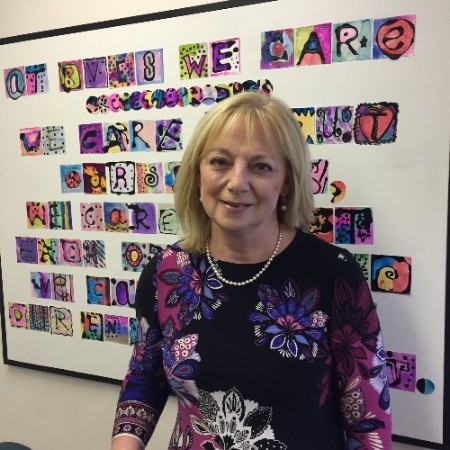 Karen Eldon will be the interim School Principal at Edgewood Elementary SchoolOn the evening of May 22, 2023, the Scarsdale Board of Education (BOE) convened to discuss a variety of topics, ranging from a review of the district-wide Safety and Emergency Management Plan (SEMP) to the Gift Proposals to Fox Meadow Elementary.
Karen Eldon will be the interim School Principal at Edgewood Elementary SchoolOn the evening of May 22, 2023, the Scarsdale Board of Education (BOE) convened to discuss a variety of topics, ranging from a review of the district-wide Safety and Emergency Management Plan (SEMP) to the Gift Proposals to Fox Meadow Elementary.
Emergency Response
The Board reviewed the SEMP in response to an incident on April 24th, when Heathcoat and Quaker Ridge initiated lockout protocols due to police activity and reports of a suspected fugitive who abandoned his car on the Hutchinson River Parkway. School staff quickly recovered students and secured the perimeters, while activities proceeded as usual inside. The decision to put school into a lockout was made with the police department, who later felt the area was secure enough to allow students to walk home and bussing to resume.
The board discussed afternoon sports, coordination with the village and bussing. Several important questions were raised. Why were parents informed of the events via text messages rather than email? Why were seemingly contradictory communications sent to the community? A member of the Board stated that there is no official protocol dictating when information should be sent by text or email and that all channels of communication are used when the information is timely and urgent. Regarding the second question, another member claimed that it is imperative to inform the community of official channels of information. The Board went on to announce that a summary of the April 24th events will be sent later this week in a community letter.
Interim Principal for Edgewood Elementary School
Following a review of the SEMP, Superintendent Dr. Drew Patrick announced new faculty that will be joining the district this year, including Edgewood’s interim principal, Karen Eldon. She served as the Principal of Bedford Elementary School for 11 years, interim principal at Coman Hill Elementary School, and then as interim principal at Fox Meadow in 2017-2018. Dr. Patrick was pleased to welcome her back into the district as Edgewood’s interim principal.
Public Comments
The night continued as Ray Dotoratos shared his concerns about the prevalence of e-learning, specifically the effect of tablets on academic performance. He stated that children today are consumed by electronics, which are designed to be addictive, and that there is no balance of usage among children. He saw the detrimental effect of e-learning on his child’s performance and asked that his child switch to paper-based learning. After the switch, he observed an immediate improvement in his child’s performance. Ultimately, he claimed that Scarsdale parents must have a right to choose between e-learning and paper-based learning, and that the school’s must be transparent in offering this decision. He started a petition on this subject that was signed by over 700 residents.
Board Succession Plan
Board President Amber Yusuf announced information on the Board leadership’s succession planning. Ron Schulhof has indicated that he is willing to serve as President, and Suzie Hahn Pascutti as Vice President. Other nominations for president and vice president will be announced and voted on at a later meeting.
Budget and Bond Vote
The Board went on to accept the May 16, 2023, Budget/Bond Vote, board election and results of voting, and the results of the High School Auditorium Bond Proposition. The bond resolution authorizing the construction of alterations and improvements to the high school auditorium was adopted for an estimated cost of $4,750,000.
Gift for Fox Meadow School
The acceptance of gift proposals to Fox Meadow Elementary School did not go nearly as smoothly. Three gifts totaling $48,215 for the construction of an outdoor classroom and student space were proposed by the Fox Meadow Elementary School PTA.
The letter from the PTA explains the rationale of giving funds for “an outdoor space to learn and play. Aside from the many educational benefits of outdoor learning, we believe that for health reasons outdoor learning spaces are more valuable than ever as we come out of a pandemic. Further, as the size of our student body continues to grow, an additional learning space would certainly be useful. This proposal will also revitalize an area of our school that is underutilized. This space is currently unused by students or faculty and it has great potential to provide an additional space for our students to congregate."
The Board’s gift policy #1800 provides that the Board approve all gifts, but board member Colleen Brown voiced her concerns. She pointed out that all gifts total close to $50,000, giving Fox Meadow a significantly larger gift for renovations than the other elementary schools.
Another member of the Board pointed out that although the gift is larger, more money might be needed by Fox Meadow Elementary to construct a space that is equitable. Ms. Brown agreed and suggested that equitable outdoor spaces must be designed first, then a price tag should be put on it. Moreover, she and other Board members questioned how the decision to endorse the capital renovations with PTA money will affect the PTA’s role in our community. Historically, the job of the PTA has not been to fundraise, and she saw capital improvement as a gift concerning. Ultimately, gifts were approved, but the board decided to revisit the gift policy under new leadership.
STAY is Here to Stay
- Details
- Written by: Caitlin Higgins
- Hits: 2325
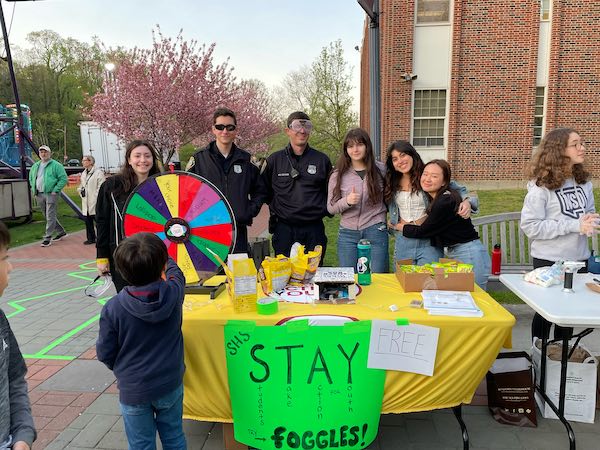 Tayt Rompala (11), Scarsdale police officers, Caitlin Higgins (11), Maya Regenstreif (11), Yeonsoo Go (11)
Tayt Rompala (11), Scarsdale police officers, Caitlin Higgins (11), Maya Regenstreif (11), Yeonsoo Go (11)
Despite numerous restrictions, many teenagers are exposed to or even consume drugs and alcohol. To raise awareness about the effects of substance use and encourage healthier lifestyles, Caitlin Higgins founded the Students Take Action for Youth Club, better known as the STAY club. Higgins recently wrote an article detailing the founding, goals, and recent community involvement of the club, which is shared below:
I am happy to announce that STAY is officially a part of Scarsdale High School. Inspired by SADD, Students Against Destructive Decisions, Students Take Action for Youth (STAY) encompasses more than just drug and alcohol awareness. The STAY Club will be a place for SHS students to learn, discuss, and take action against substance abuse in addition to supporting teens’ mental wellbeing. We are focused on looking deeper into the truths about substances in our community and larger society. Many of the things we believe to be true about substances are, in fact, untrue and misleading. We are here to spread the truth. Our goal is to educate students about substance misuse, separating fact from fiction, and allowing students to make informed decisions that will lead to healthier lifestyles.
As a long-time member of Scarsdale Action for Youth, I have been active in planning, speaking, and conducting activities for my peers and the community. Through events like Light The Dale and The Scarsdale Car Show we’ve worked to bring attention to the issue in a supportive and approachable way. I also spoke in front of the Village Hall Board of Trustees, objecting to the allowance of marijuana dispensaries in our village. Earlier this year in February, SAY sent me to Washington, DC to attend the National CADCA convention, where I had the thrilling opportunity to address our New York politicians and gave a youth perspective in support of New York State bills and funding for substance abuse prevention, early intervention, and treatment programs. Yet, after returning, I wanted a place where students can work together in an independent and more personal setting. When I applied to be a club, Jessica Levenberg, the SHS health teacher, agreed to be the STAY club advisor.
After being passed, we planned an ambitious schedule with at least one event each month in order to best keep organized and to make each month meaningful. Two weeks ago, in preparation for 4/20 Day, the STAY Club along with SMS 8th graders, met up at Italian Village Pizzeria, and stickered close to 400 pizza boxes with different messages about the harms of marijuana use in order to spread a less aggressive message. The next day, we also hosted an SHS Club table at the annual SHS carnival, continuing the marijuana awareness theme. Alongside our table, we taped a green zig zag line on the pavement. Participants walked the line while wearing “Foggles,” simulation goggles that replicate the physical effects of marijuana and alcohol impairment. Many students and adults were surprised by the impairment they experienced, which included concentration, coordination, depth perception, and even nausea. Judging by the lines of people, we know that this activity was very well received. The Scarsdale Police stopped by and gave it a try as well. With all of this positive reinforcement, STAY is beginning to build its name.
STAY was honored to be asked by the SHS administrators to participate in Non Sibi Day on May 26th—a day of community service and present a topic of our choosing. We felt it was important to do NARCAN training for SHS’ 16+ year-olds to address the fentanyl and opioid epidemic— the worst drug crisis in US history. We recognize it’s an uncomfortable and gruesome topic, but so important for students to be informed and help protect themselves and others. We want to help prepare our peers in the best way possible for any situation they may encounter.
Our next activity is a Post-It note event where we will write encouraging messages on post-its and place them on the 8th grader’s lockers in order to welcome them to the high school and congratulate them on their successes so far. We aim to form tight connections with members of the whole community– not just high school students. The event will be on Tuesday, May 16. Anyone is free to join us and we hope to have a great turn out!
In the future, there are many more events on the schedule and we hope that with each STAY exposure, SHS students will join and get involved with our initiative. Our message is one of truth and action, but we will also have fun doing it together. In other words, STAY is here to stay.










